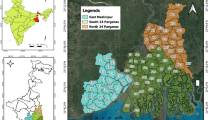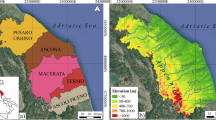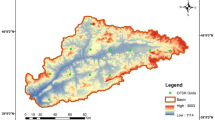Abstract
In the present study, 4 gridded satellite precipitation data products for September 2014 flood, IMERG (Integrated Multi-satellitE Retrievals for GPM), GSMaP (Global Satellite Mapping of Precipitation), TRMM-3B42 (Tropical Rainfall Measuring Mission) and INSAT-3D-IMR (INSAT Multispectral Rain), were evaluated against the Indian Meteorological Department rain-gauge data from Sep-1st to Sep-7th 2014. Three evaluation indices; Correlation coefficient (CC), the Relative bias (RB) and the Nash-Sutcliffe coefficient (NSC), were used to evaluate the robustness of satellite precipitation estimates with actual rainfall measurements. IMERG precipitation product has a near perfect positive CC and NSC values of 0.94 and 0.99 respectively; while the CC and NSC values are 0.7 and 0.5 for GSMaP_Gauge; 0.69 and 0.05 for INSAT-3D-IMR; and 0.9 and 0.8 for TRMM-3B42 respectively. The RB estimates indicate that IMERG, with a bias of 2%, is a best-fit dataset when compared to the surface rain-gauge observations. In contrast, TRMM-3B42, GSMaP and INSAT-3D-IMR have underestimation biases of −31%, −58%, and − 86% respectively. Analysis of the indices indicates that IMERG precipitation product performed better than other three satellite precipitation products owing to the closeness of values with surface gauge station data over Kashmir. Owing to scanty observation of rainfall in the region, IMERG has a potential to become a cost effective input data source for designing a flood early warning system (FEWS) for Kashmir. However, it is suggested to evaluate the robustness of different satellite-derived precipitation estimates compared to rain gauge observations by incorporating more extreme events from different mountain regions globally for establishing the best satellite derived precipitation product.





Similar content being viewed by others
References
Anagnostou, E.N., Maggioni, V., Nikolopoulos, E.I., Meskele, T., Hossain, F., Papadopoulos, A.: Benchmarking high-resolution global satellite rainfall products to radar and rain-gauge rainfall estimates. IEEE Trans. Geosci. Remote Sens. 48, 1667–1683 (2010). https://doi.org/10.1109/TGRS.2009.2034736
Asong, Z., Razavi, S., Wheater, H.S., Wong, J.: Evaluation of integrated multi-satellitE retrievals for GPM (IMERG) over southern Canada against ground precipitation observations: a preliminary assessment. J. Hydrometeorol. 18, 1033–1050 (2017). https://doi.org/10.1175/JHM-D-16-0187.1
Bagnolus, F., Meher-Homji, V.M.: Bioclimatic types of South East Asia. Travaux de la Section Scientific at Technique Institute Franscis de Pondicherry: 277 (1959)
Bhatt, C.M., Rao, G.S., Farooq, M., Manjusree, P., Shukla, A., Sharma, S.V.S.P., Kulkarni, S.S., Dadhwal, V.K.: Satellite-based assessment of the catastrophic Jhelum floods of September 2014, Jammu & Kashmir, India. Geomat Nat Haz Risk. 8, 309–327 (2017). https://doi.org/10.1080/19475705.2016.1218943
Borga, M., Vizzaccaro, A.: On the interpolation of hydrologic variables: formal equivalence of multiquadratic surface fitting and kriging. J. Hydrol. 195, 160–171 (1997). https://doi.org/10.1016/S0022-1694(96)03250-7
Brown, J.E.M.: An analysis of the performance of hybrid infrared and microwave satellite precipitation algorithms over India and adjacent regions. Remote Sens. Environ. 101(1), 63–81 (2006). https://doi.org/10.1016/j.rse.2005.12.005
Chang, D.E., Lee, D.K., Park, S.K.: Observational experiment and predictability of high-impact weather. Asia-Pac. J. Atmos. Sci. 46(3), 231–232 (2010). https://doi.org/10.1007/s13143-010-1013-0
Chen, Y., Ebert, E.E., Walsh, K.J.E., Davidson, N.E.: Evaluation of TRMM 3B42 precipitation estimates of tropical cyclone rainfall using PACRAIN data. J. Geophys. Res.-Atmos. 118, 2184–2196 (2013). https://doi.org/10.1002/jgrd.50250
Creutin, J.D., Obled, C.: Objective analysis and mapping techniques for rainfall fields. An objective comparison. Water Resour. Res. 18(2), 413–431 (1982). https://doi.org/10.1029/WR018i002p00413
Dar, R.A., Romshoo, S.A., Chandra, R., Ahmad, I.: Tectono-geomorphic study of the Karewa Basin of Kashmir Valley. J. Asian Earth Sci. 92, 143–156 (2014). https://doi.org/10.1016/j.jseaes.2014.06.018
Dinku, T., Ceccato, P., Grover-Kopec, E., Lemma, M., Connor, S.J., Ropelewski, C.F.: Validation of satellite rainfall products over complex terrain. Int. J. Remote Sens. 29(14), 4097–4110 (2007). https://doi.org/10.1080/01431160600954688.
Gairola, R.M., Prakesh, S., Bushair, M.T., Pal, P.K.: Rainfall estimation from Kalpana-1 satellite data over Indian land and oceanic regions. Curr. Sci. 107(8), 1275–1282 (2014)
Gumindoga, W., Rientjes, T.H.M., Haile, A.T., Makurira, H., Reggiani, P.: Bias correction schemes for CMORPH satellite rainfall estimates in the Zambezi River basin. Hydrol. Earth Syst. Sci. Discuss. 1–36 (2016). https://doi.org/10.5194/hess-2016-33
Hirpa, F.A., Gebremichael, M., Hopson, T.: Evaluation of high-resolution satellite precipitation products over very complex terrain in Ethiopia. J. Appl. Meteorol. Climatol. 49, 1044–1051 (2010). https://doi.org/10.1175/2009JAMC2298.1
Hong, Y., Adler, R.F., Negri, A., Huffman, G.J.: Flood and landslide applications of near real-time satellite rainfall products. Nat. Hazards. 43(2), 285–294 (2007). https://doi.org/10.1007/s11069-006-9106.
Huffman, G.J.: The Transition in Multi-Satellite Products from TRMM to GPM (TMPA to IMERG).” Available at: https://pmm.nasa.gov/sites/default/files/document_files/TMPA-to-IMERG_transition.pdf (2015). Accessed on: 30th June, 2017
Huffman, G.J., Adler, R.F., Bolvin, D.T., Nelkin, E.J., Hossain, F., Gebremichael, M.: The TRMM Multi-Satellite Precipitation Analysis (TMPA)”. Satellite Rainfall Applications for Surface Hydrology; Springer: Dordrecht, The Netherlands: 3–22 (2010)
Huffman, G.J., Bolvin, D.T., Braithwaite, D., Hsu, K., Joyce, R., Xie, P., Yoo, S.H.: NASA global precipitation measurement (GPM) integrated multi-satellite retrievals for GPM (IMERG). Algorithm Theoretical Basis Document (ATBD), NASA/GSFC, Greenbelt, MD, USA. Available at: https://pmm.nasa.gov/sites/default/files/document_files/IMERG_ATBD_V4.4.pdf (2014). A ccessed on: 30th June, 2017
Huffman, G.J., Bolvin, D.T., Braithwaite, D., Hsu, K., Joyce, R., Kidd, C., Nelkin, E.J., Xie, P.: Algorithm Theoretical Basis Document (ATBD) Version 4.5. NASA Global Precipitation Measurement (GPM) Integrated Multi-satellitE Retrievals for GPM (IMERG). NASA (2015)
Jiang, S.H., L, L., Ren, B., Yong, X.L.Y., Shi, L.: Evaluation of high-resolution satellite precipitation products with surface rain gauge observations from Laohahe Basin in northern China. Water Sci Eng. 3(4), 405–417 (2010). https://doi.org/10.3882/j.issn.1674-2370.2010.04.004.
Kalinga, O.A., Gan, T.Y.: Estimation of rainfall from infrared-microwave satellite data for basin-scale hydrologic modelling. Hydrol. Process. 24, 2068–2086 (2010). https://doi.org/10.1002/hyp.7626
Koriche, S.A., Rientjes, T.H.M.: Application of satellite products and hydrological modeling for flood early warning. Phys. Chem. Earth. 93, 1–12 (2016). https://doi.org/10.1016/j.pce.2016.03.007.
Krakauer, N., Pradhanang, S., Lakhankar, T., Jha, A.: Evaluating satellite products for precipitation estimation in mountain regions: a case study for Nepal. Remote Sens. 5, 4107–4123 (2013). https://doi.org/10.3390/rs5084107
Kumar, R., Acharya, P.: Flood hazard and risk assessment of 2014 floods in Kashmir Valley: a space-based multisensor approach. Nat. Hazards. 84, 437–464 (2016). https://doi.org/10.1007/s11069-016-2428-4.
Li, X.H., Zhang, Q., Xu, C.Y.: Suitability of the TRMM satellite rainfalls in driving a distributed hydrological model for water balance computations in Xinjiang catchment, Poyang Lake basin. J. Hydrol. 427, 28–38 (2012). https://doi.org/10.1016/j.jhydrol.2012.01.013
Liu, Z.: Comparison of integrated multisatellite retrievals for GPM (IMERG) and TRMM multisatellite precipitation analysis (TMPA) monthly precipitation products: initial results. J. Hydrometeorol. 17, 777–790 (2016). https://doi.org/10.1175/JHM-D-15-0068.1
Maggioni, V., Meyers, P.C., Robinson, M.D.: A review of merged high resolution satellite precipitation product accuracy during the tropical rainfall measuring Mission (TRMM) era. J. Hydrometeorol. 17, 1101–1117 (2016). https://doi.org/10.1175/JHM-D-15-0190.1
Mantas, V.M., Liu, Z., Caro, C., Pereira, A.J.S.C.: Validation of TRMM multi-satellite precipitation analysis (TMPA) products in the Peruvian Andes. Atmos. Res. 163, 132–145 (2014). https://doi.org/10.1016/j.atmosres.2014.11.012.
Miao, Q., Yang, D., Yang, H., Li, Z.: Establishing a rainfall threshold for flash flood warnings in China’s mountainous areas based on a distributed hydrological model. J. Hydrol. 541, 371–386 (2016). https://doi.org/10.1016/j.jhydrol.2016.04.054
Michaelides, S., Levizzani, V., Anagnostou, E., Bauer, P., Kasparis, T., Lane, J.E.: Precipitation: measurement, remote sensing, climatology and modeling. Atmos. Res. 94, 512–533 (2009). https://doi.org/10.1016/j.atmosres.2009.08.017
Mishra, A.K.: A study on the occurrence of flood events over Jammu and Kashmir during September 2014 using satellite remote sensing. Nat. Hazards. 78, 1463–1467 (2015). https://doi.org/10.1007/s11069-015-1768-9.
Mishra, A., Gairola, R.M., Varma, A.K., Agarwal, V.K.: Study of intense rainfall events over India using Kalpana-IR and TRMM-precipitation radar observations. Curr. Sci. 97(5), 689–695 (2009)
Nair, S., Srinivasan, G., Nemani, R.: Evaluation of multi-satellite TRMM derived rainfall estimates over a western state of India. J. Meteorol. Soc. Jpn. 87(6), 927–939 (2009). https://doi.org/10.2151/jmsj.87.927
Nash, J.E., Sutcliffe, J.V.: River flow forecasting through conceptual models, part 1: a discussion of principles. J. Hydrol. 10(3), 282–290 (1970). https://doi.org/10.1016/0022-1694(70)90255-6
Negri, A.J., Xu, L., Adler, R.F.: A TRMM-calibrated infrared rainfall algorithm applied over Brazil. J. Geophys. Res.-Atmos. 107(20), (2002). https://doi.org/10.1029/2000JD000265
Okamoto, K., Ushio, T., Iguchi, T., Takahashi, N., Iwanami, K.: The global satellite mapping of precipitation (GSMaP) project. In: Proceedings of the 2005 IEEE International Geoscience and Remote Sensing Symposium, IGARSS ‘05, Seoul, Korea, July 25–29, vol. 5, pp. 3414–3416 (2005)
Pearson, K., Lee, A.: Mathematical contributions to the theory of evolution. On Telegony in Man, &c. Proc Royal Soc Lond. 60, 273–283 (1896). https://doi.org/10.1098/rspl.1896.0048.
Prakash, S., Mitra, A.K., Momin, I.M., Rajagopal, E.N., Basu, S.: Agreement between monthly land rainfall estimates from TRMM-PR and gauge-based observations over South Asia. Remote Sens Lett. 5(6), 558–567 (2014). https://doi.org/10.1080/2150704X.2014.934401
Prakash, S., Mitraa, A.K., Paic, D.S., AghaKouchakd, A.: From TRMM to GPM: how well can heavy rainfall be detected from space? Adv. Water Resour. 88, 1, –7 (2016a). https://doi.org/10.1016/j.advwaters.2015.11.008
Prakash, S., Mitra, A.K., Rajagopal, E.R., Pai, D.S.: Assessment of TRMM-based TMPA-3B42 and GSMaP precipitation products over India for the peak southwest monsoon season. Int. J. Climatol. 36, 1614–1631 (2016b). https://doi.org/10.1002/joc.4446
Qin, Y., Chen, Z., Zhang, S., Shen, Y., Shi, R.: Evaluation of satellite rainfall estimates over the Chinese mainland. Remote Sens. 6, 11649–11672 (2014). https://doi.org/10.3390/rs61111649
Rashid, I., Romshoo, S.A., Chaturvedi, R.K., Ravindranath, N.H., Sukumar, R., Jayaraman, M., Lakshmi, T.V., Sharma, J.: Projected climate change impacts on vegetation distribution over Kashmir Himalayas. Clim. Chang. 132, 601–613 (2015). https://doi.org/10.1007/s10584-015-1456-5
Rashid, I., Romshoo, S.A., Hajam, J.A., Abdullah, T.: A semi-automated approach for mapping geomorphology in mountainous terrain, Ferozpora watershed (Kashmir Himalaya). J. Geol. Soc. India. 88(2), 206–212 (2016). https://doi.org/10.1007/s12594-016-0479-5
Rashid, I., Romshoo, S.A., Abdullah, T.: The recent deglaciation of Kolahoi valley in Kashmir Himalaya, India in response to the changing climate. J. Asian Earth Sci. 138, 38–50 (2017). https://doi.org/10.1016/j.jseaes.2017.02.002
Ray, K., Bhan, S.C., Bandopadhyay, B.K.: The catastrophe over Jammu and Kashmir in September 2014: a meteorological observational analysis. Curr. Sci. 109(3), 580–591 (2015)
Richard, F., Arkin, P.: On the relationship between satellite-observed cloud cover and precipitation. Mon. Weather Rev. 109, 1081–1093 (1981)
Romshoo, S.A., Rashid, I.: Potential and constraints of geospatial data for precise assessment of the impacts of climate change at landscape level. Int J Geomat Geosci. 1(3), 386–405 (2010)
Romshoo, S.A., Bhat, S.A., Rashid, I.: Geoinformatics for assessing the morphometric control on hydrological response at watershed scale in the upper Indus Basin. J Earth Syst Sci. 121(3), 659–686 (2012). https://doi.org/10.1007/s12040-012-0192-8
Romshoo, S.A., Rafiq, M., Rashid, I.: Spatio-temporal variation of land surface temperature and temperature lapse rate over mountainous Kashmir Himalaya. J. Mt. Sci. 15(3), 563–576 (2018a). https://doi.org/10.1007/s11629-017-4566-x
Romshoo, S.A., Altaf, S., Rashid, I., Dar, R.A.: Climatic, geomorphic and anthropogenic drivers of the 2014 extreme flooding in the Jhelum basin of Kashmir, India. Geomat Nat Haz Risk. 9(1), 224–248 (2018b). https://doi.org/10.1080/19475705.2017.1417332
Samaniego, L., Kumar, R., Jackisch, C.: Predictions in a data-sparse region using a regionalized grid-based hydrologic model driven by remotely sensed data. Hydrol. Res. 42(5), 338–355 (2012). https://doi.org/10.2166/nh.2011.156.
Sandeep, S., Stordal, F.: Use of daily outgoing longwave radiation (OLR) data in detecting precipitation extremes in the tropics. Remote Sens Lett. 4(6), 570–578 (2013). https://doi.org/10.1080/2150704X.2013.769284
Sharifi, E., Steinacker, R., Saghafian, B.: Assessment of GPM-IMERG and other precipitation products against gauge data under different topographic and climatic conditions in Iran: preliminary results. Remote Sens. 8, 135 (2016). https://doi.org/10.3390/rs8020135
Shrestha, M.S., Artan, G.A., Bajracharya, S.R., Sharma, R.R.: Applying satellite based rainfall estimates for streamflow modelling in the Bagmati basin, Nepal. J Flood Risk Manage. 1, 89–99 (2008). https://doi.org/10.1111/j.1753-318x.2008.00011.x.
Shrestha, M.S., Takara, K., Kubota, T., Bajracharya, S.R.: Verification of GSMaP rainfall estimates over the Central Himalayas. Journal of Japan Society of Civil Engineers. 67(4), 37–42 (2011)
Singh, O., Kumar, M.: Flood events, fatalities and damages in India from 1978 to 2006. Nat. Hazards. 69, 1815–1834 (2013). https://doi.org/10.1007/s11069-013-0781-0
Su, F.G., Hong, Y., Lettenmaier, D.P.: Evaluation of TRMM multisatellite precipitation analysis (TMPA) and its utility in hydrologic prediction in the La Plata Basin. J. Hydrometeorol. 9(4), 622–640 (2008)
Tabios, G.Q., Salas, J.D.: A comparative analysis of techniques for spatial interpolation of precipitation. J. Am. Water Resour. Assoc. 21, 365–380 (1985). https://doi.org/10.1111/j.1752-1688.1985.tb00147.x
Toté, C., Patricio, D., Boogaard, H., Wijngaart, R., Tarnavsky, E., Funk, C.: Evaluation of satellite rainfall estimates for drought and flood monitoring in Mozambique. Remote Sens. 7, 1758–1776 (2015). https://doi.org/10.3390/rs70201758
Tullos, D., Byron, E., Galloway, G., Obeysekera, J., Prakash, O., Sun, Y.H.: Reviewof challenges of and practices for sustainable management of mountain flood hazards. Nat. Hazards. 83, 1763–1797 (2016). https://doi.org/10.1007/s11069-016-2400-3
Ushio, T., Sasashige, K., Kubota, T., Shige, S., Okamoto, K., Aonashi, K., Inoue, T., Takahashi, N., Iguchi, T., Kachi, M.A.: A Kalman filter approach to the global satellite mapping of precipitation (GSMaP) from combined passive microwave and infrared radiometric data. J. Meteorol. Soc. Jpn. 87, 137–151 (2009). https://doi.org/10.2151/jmsj.87A.137
Wang, X.L., Lin, A.: An algorithm for integrating satellite precipitation estimates with in situ precipitation data on a pentad time scale. J. Geophys. Res. - Atmos. 120, 3728–3744 (2015). https://doi.org/10.1002/2014JD022788
World Bank: Environment and social management framework, Jhelum and Tawi flood recovery project. project management unit, J&T FRP, government of Jammu and Kashmir. [Updated 2015 April 18; Cited 2016 November 8]. Available from: http://jkrevenue.nic.in/pdf/Relief_rehab/JTFRP_Draft_ESMF_18.04.2015.pdf
Yang, Y., Luo, Y.: Evaluating the performance of remote sensing precipitation products CMORPH, PERSIANN, and TMPA, in the arid region of Northwest China. Theor. Appl. Climatol. 118(3), 429–445 (2014). https://doi.org/10.1007/s00704-013-1072-0
Zulkafli, Z., Buytaert, W., Onof, C., Bastian, M., Tarnavsky, E., Lavado, W., Guyot, J.: A comparative performance analysis of TRMM 3B42 (TMPA) versions 6 and 7 for hydrological applications over Andean–Amazon River basins. J. Hydrometeorol. 15, 581–592 (2014). https://doi.org/10.1175/JHM-D-13-094.1
Acknowledgements
The authors express gratitude to the two anonymous reviewers for their valuable comments and suggestions on the earlier version of the manuscript that greatly improved the content and structure of this manuscript. The authors express gratitude to IMD for providing the AWS data of the September 2014 flood event. We are also thankful to NASA, JAXA and ISRO for the free distribution of satellite-based precipitation estimates.
Author information
Authors and Affiliations
Corresponding author
Additional information
Responsible editor: Soon-Il An
Rights and permissions
About this article
Cite this article
Rashid, I., Parray, A.A. & Romshoo, S.A. Evaluating the Performance of Remotely Sensed Precipitation Estimates against In-Situ Observations during the September 2014 Mega-Flood in the Kashmir Valley. Asia-Pacific J Atmos Sci 55, 209–219 (2019). https://doi.org/10.1007/s13143-018-0071-6
Received:
Revised:
Accepted:
Published:
Issue Date:
DOI: https://doi.org/10.1007/s13143-018-0071-6




